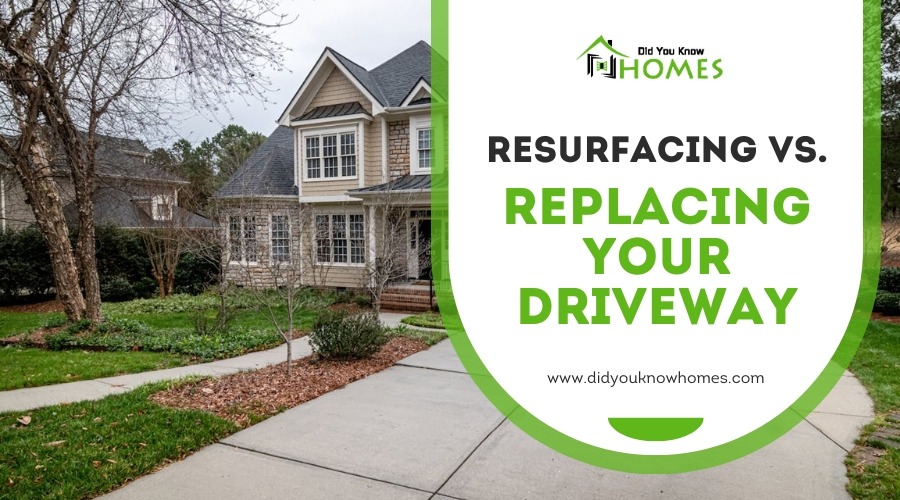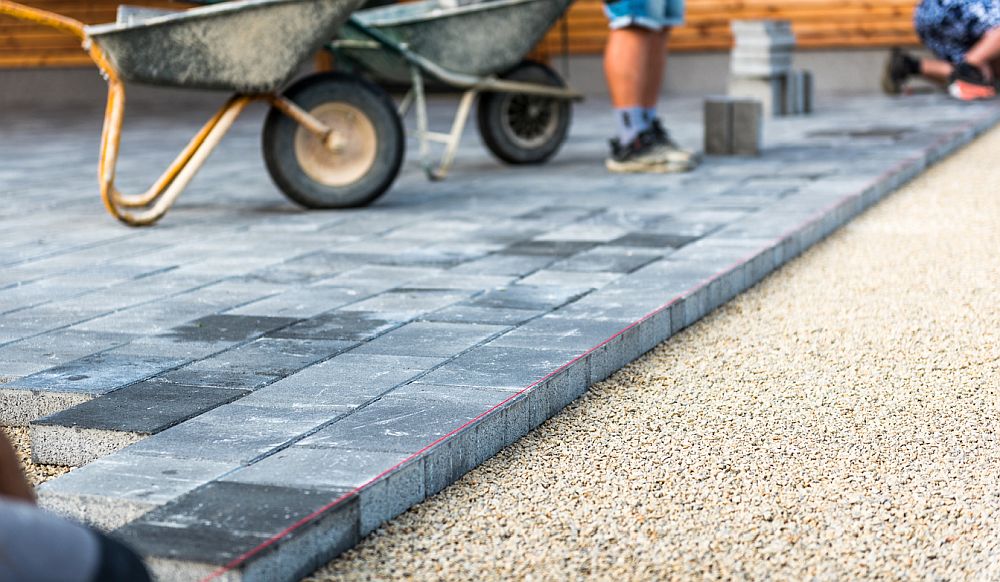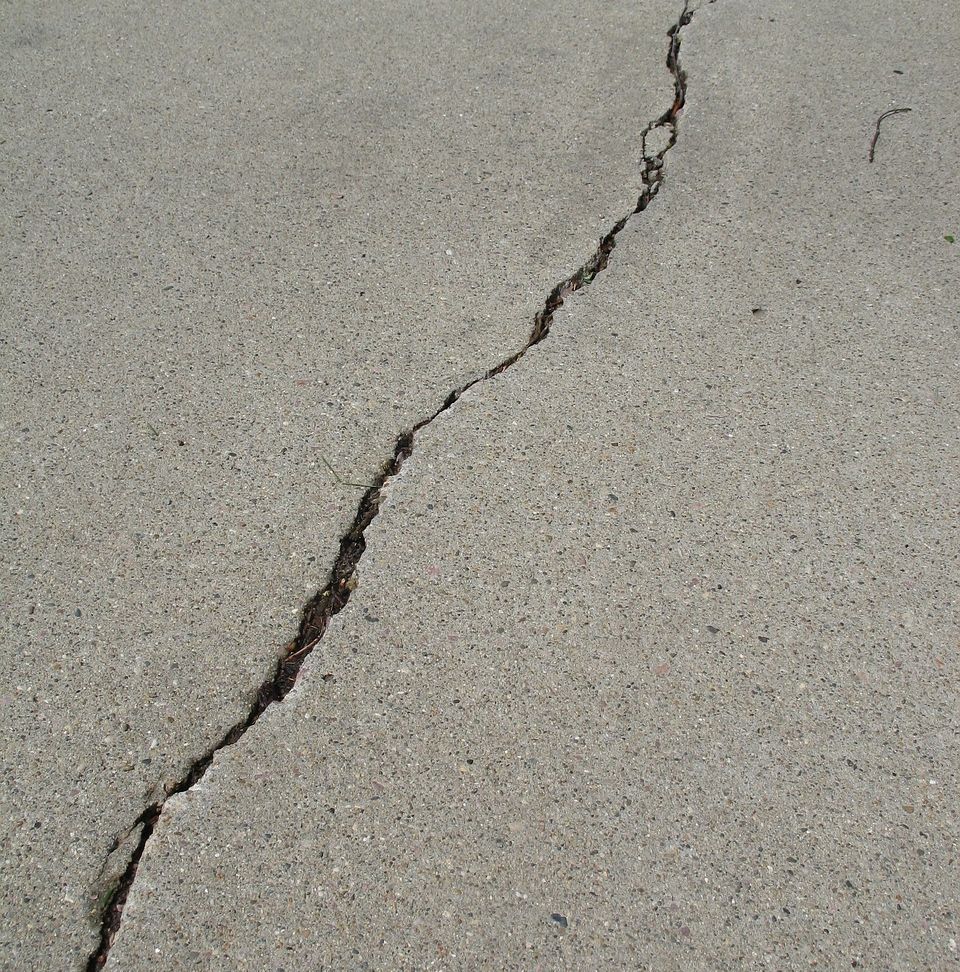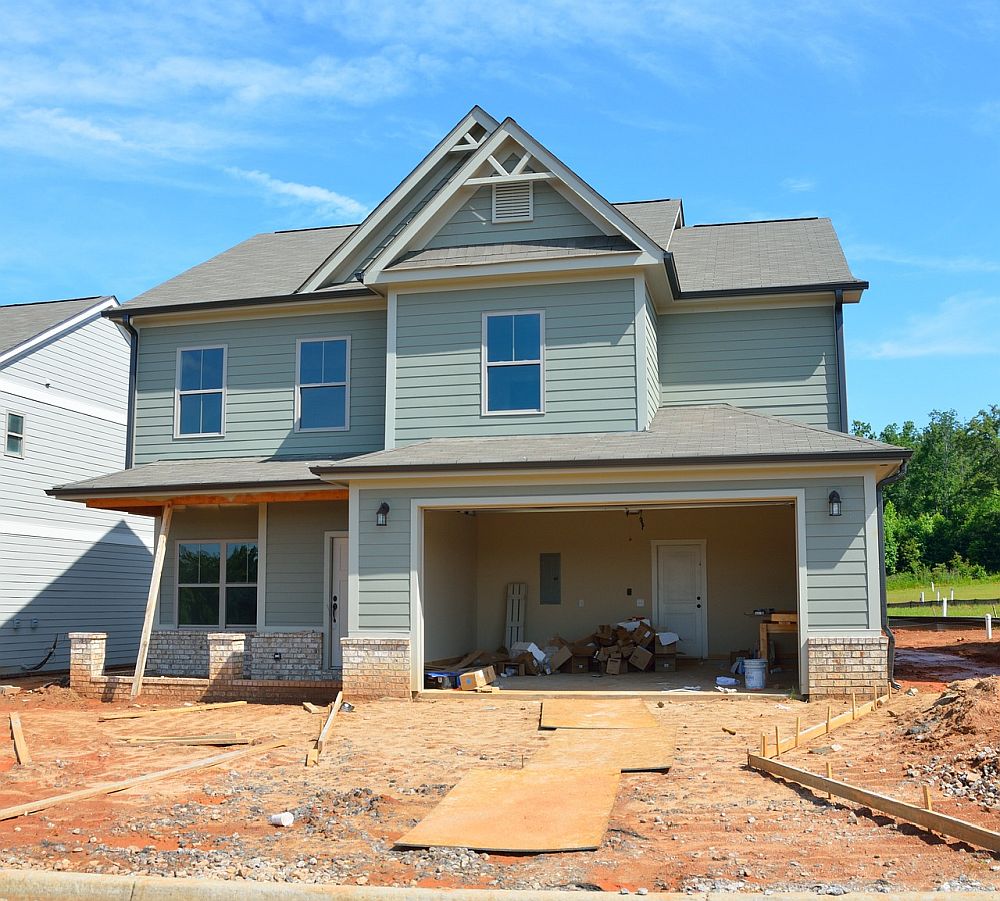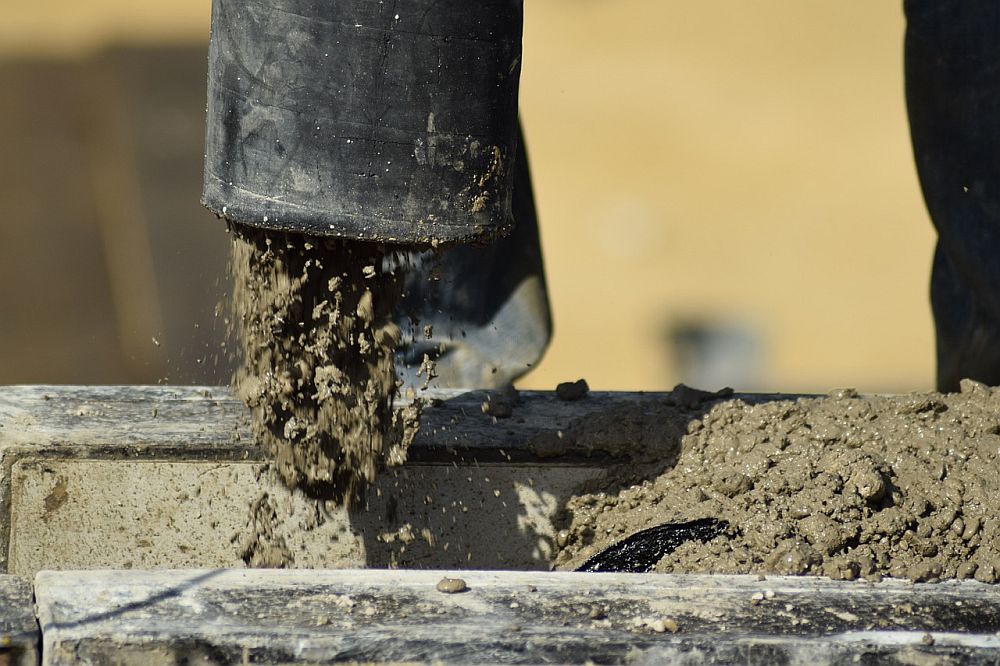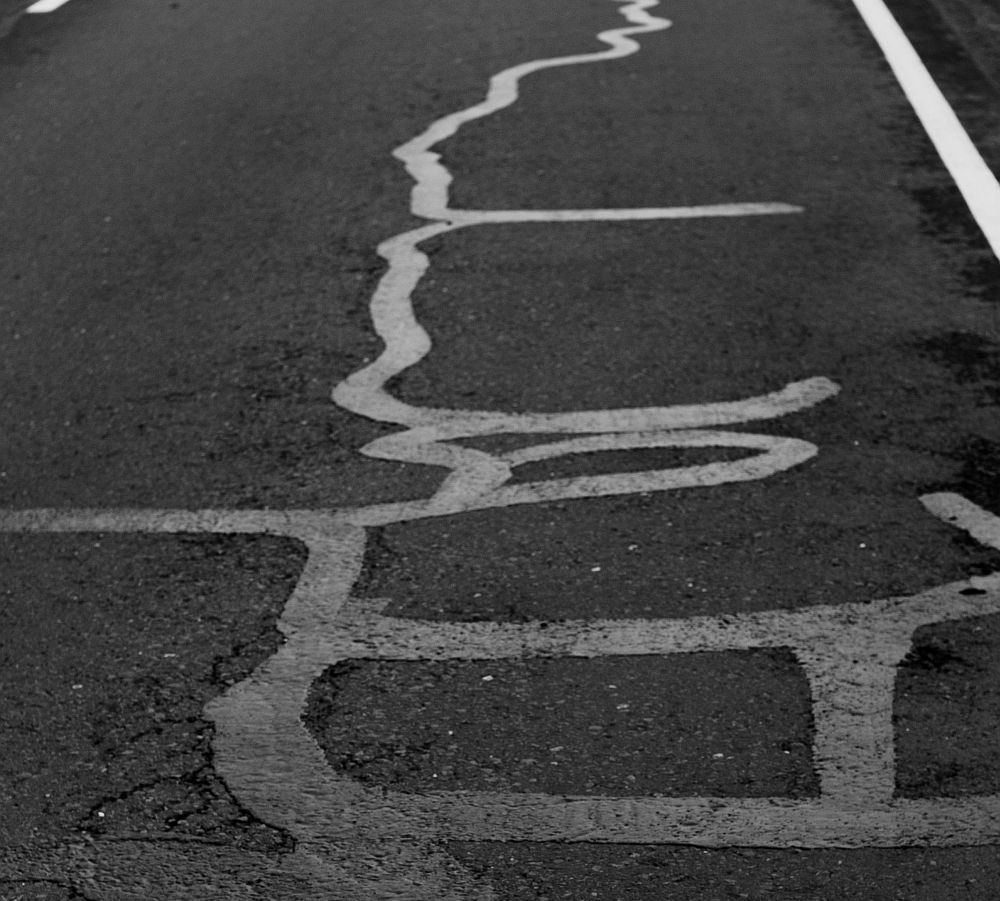When it comes to enhancing your home’s exterior, the condition of your driveway plays a pivotal role. Homeowners are often faced with a critical choice: resurfacing or replacing their driveway. Resurfacing, a process that rejuvenates the existing surface with a new layer, is a budget-friendly and quick solution for minor wear and tear. On the other hand, replacing a driveway involves removing the old surface entirely and laying down a new one, addressing deeper structural issues and providing an opportunity for a complete aesthetic overhaul.
This decision not only impacts the curb appeal and functionality of your property but also its future resilience. Through a detailed exploration of both options, this guide aims to arm you with the insights needed to make an informed decision that aligns with your home’s needs, aesthetic preferences, and budget constraints.
What is driveway resurfacing?
Driveway resurfacing involves applying a new layer of material over the existing driveway surface. This process is designed to rejuvenate and extend the life of a driveway without the need for complete replacement. Ideal for addressing minor imperfections such as small cracks or discolorations, resurfacing can significantly improve a driveway’s appearance and durability. By choosing this option, homeowners can avoid the higher costs and longer downtimes associated with full driveway replacements. Resurfacing offers a cost-effective way to enhance curb appeal and functionality, making it a preferred choice for driveways that retain a solid foundation but show signs of surface-level wear.
What is driveway replacement?
Driveway replacement entails the complete removal of the existing driveway surface and the installation of a new one from the ground up. This process is typically recommended for driveways that suffer from severe damage or structural issues that cannot be effectively addressed through resurfacing. Replacement provides a long-term solution for aging driveways, allowing for not only the repair of deep cracks and potholes but also the opportunity to update the driveway’s design for aesthetic or functional improvements. While more time-consuming and costly than resurfacing, replacing a driveway offers a fresh start, ensuring durability and enhancing the property’s overall value and appeal.
Why resurface instead of replace?
Choosing to resurface a driveway instead of replacing it is often driven by three key considerations: cost-effectiveness, time efficiency, and environmental considerations. Resurfacing is significantly less expensive than a full replacement, making it an attractive option for homeowners looking to extend the lifespan of their driveway without a hefty investment.
Additionally, the process of resurfacing is less time-consuming, allowing for a quicker turnaround and minimal disruption to daily life. Environmental benefits also play a crucial role in the decision to resurface, as this option reduces the amount of waste generated by removing the old driveway and utilizes fewer resources by refurbishing the existing surface. This approach not only saves money and time but also aligns with sustainable practices by minimizing the environmental footprint of driveway maintenance.
Cost-effective
Resurfacing a driveway is notably cost-effective because it utilizes the existing driveway structure, avoiding the higher costs associated with demolishing and rebuilding from scratch. On average, resurfacing a driveway can cost between $2 to $5 per square foot, whereas replacing a driveway can range from $5 to $15 per square foot, depending on the material chosen. This approach yields significant savings, making driveway enhancements feasible within a modest budget. The financial benefits of resurfacing make it an appealing option for homeowners looking to improve their property’s appearance and functionality without a substantial financial outlay.
Less time-consuming
The process of resurfacing a driveway is inherently less time-consuming than undertaking a full replacement. Resurfacing typically completes within a few days, whereas replacing a driveway can take up to a week or more, depending on the extent of the work and conditions. This swift turnaround minimizes inconvenience, swiftly restoring access and use of the driveway, which is particularly beneficial for busy households.
Environmental considerations
Choosing to resurface a driveway over replacing it offers noteworthy environmental advantages. Resurfacing reduces waste by repurposing the existing surface material, thereby minimizing the amount of debris directed to landfills. Furthermore, it is estimated that resurfacing utilizes up to 50% fewer new materials compared to a full replacement, promoting resource conservation. Additionally, the carbon footprint associated with resurfacing is significantly lower due to reduced material production and transportation requirements. Resurfacing represents a sustainable choice, aligning with eco-friendly practices by diminishing the environmental footprint associated with driveway maintenance and renovation.
By considering these factors, homeowners can make an informed decision that not only benefits their budget and schedule but also contributes positively to environmental sustainability.
Why replace instead of resurface?
Opting to replace a driveway rather than resurface it is often justified by severe damage that goes beyond superficial flaws, where the structural integrity of the driveway is compromised. Replacement offers a long-term solution for driveways that are aging and where resurfacing would merely act as a temporary fix. Furthermore, replacement presents an opportunity to update the driveway’s design, catering to both aesthetic preferences and functional improvements. This option, while more costly and time-intensive, ensures the longevity and resilience of the driveway, ultimately enhancing the property’s value and appeal. Through replacement, homeowners can address underlying issues that could lead to future problems, securing a durable and visually pleasing driveway for years to come.
Severe damage beyond simple repairs
When a driveway endures severe damage—such as extensive cracking, heaving, or potholes—mere patchwork or filling may not be adequate. These issues often signal compromised structural integrity, making a complete replacement not just advisable but necessary for safety and functionality. Examples of damage types that typically require replacement include:
- Foundation issues: When the base of the driveway has shifted or eroded, leading to uneven surfaces and significant cracks.
- Extensive water damage: Prolonged exposure to water can undermine the driveway’s foundation, causing it to sink or develop large cracks.
- Severe weathering: In areas with harsh climates, driveways can suffer from freeze-thaw cycles, leading to scaling, spalling, and cracking that penetrate deep into the surface.
Long-term solution for aging driveways
A replaced driveway, depending on the material used, can last anywhere from 20 to 40 years, significantly longer than a resurfaced driveway, which might extend the life of the existing driveway by 8 to 15 years. This makes replacement a more cost-effective solution in the long run for driveways that have reached or exceeded their lifespan.
Updating driveway design for aesthetic or functional improvements
A complete driveway replacement presents an opportunity to revamp its design, aligning with both aesthetic preferences and functional needs. Examples of design and functional improvements include:
- Adding drainage systems: To prevent water accumulation and protect the driveway’s structural integrity.
- Changing the driveway layout: To improve accessibility, increase parking space, or enhance the property’s curb appeal.
- Upgrading materials: Homeowners can choose more durable or aesthetically pleasing materials that were not previously available or affordable.
By considering these factors, homeowners can make an informed decision that not only addresses immediate structural concerns but also enhances the long-term value and functionality of their property.
Determining driveway needs: resurfacing or replacing?
Deciding whether to resurface or replace a driveway hinges on a thorough assessment of the extent of damage. This involves examining the driveway for signs of cracks, potholes, and drainage issues which can indicate underlying problems. While minor cracks and surface-level wear might be effectively remedied with resurfacing, deep cracks, significant potholes, and compromised structural integrity typically necessitate a full replacement. Consulting with professionals is crucial in this determination process. Experts can provide an in-depth evaluation, offering insights into the most cost-effective and long-lasting solutions tailored to the driveway’s condition. Their expertise ensures that homeowners make an informed decision that addresses both immediate concerns and future durability, aligning with both budget and long-term property maintenance goals.
Assessing the extent of damage
The initial step in deciding the appropriate course of action for a driveway is assessing the extent of damage. Specific signs that indicate a driveway needs more than just resurfacing include:
- Large cracks wider than a quarter-inch: Especially those that are deep and reach the foundation.
- Multiple potholes: Indicating underlying issues with the driveway’s base or subgrade.
- Drainage problems: Standing water or consistent drainage issues that erode the driveway material.
- Surface crumbling or flaking (spalling): Extensive areas where the surface is deteriorating beyond superficial damage.
A thorough assessment helps in distinguishing between surface-level wear and more severe structural problems, guiding the decision-making process effectively.
Consulting with professionals
Engaging in consultation with professionals is a vital step towards making an informed decision. When selecting a driveway maintenance and repair specialist, homeowners should look for the following qualifications or credentials:
- Licensing and Insurance: Ensure the professional is licensed to perform driveway repair and replacement work in your area and carries liability insurance.
- Experience: Look for a contractor with extensive experience specifically in driveway installation and maintenance.
- References and Reviews: Check for positive reviews and ask for references from previous clients to gauge the quality of their work.
- Professional Associations: Membership in professional associations can indicate a commitment to industry standards and ongoing education.
Driveway maintenance and repair specialists possess the knowledge and tools to accurately evaluate the extent of damage and recommend the most appropriate intervention—be it resurfacing or full replacement. Their advice is grounded in expertise and practical experience, ensuring homeowners receive reliable guidance.
Importance of expert evaluations
The importance of expert evaluations in this context is paramount. Professional assessments provide a detailed understanding of the driveway’s condition, uncovering potential issues that may not be immediately apparent to the untrained eye. This level of insight is crucial for making decisions that are both cost-effective and beneficial in the long term, preventing unnecessary expenditure and ensuring the longevity and safety of the driveway.
Steps in resurfacing a driveway
Resurfacing a driveway involves a structured approach that starts with cleaning and repairing cracks to ensure the surface is primed for the new layer. This initial step is crucial for removing any debris and addressing imperfections that could undermine the resurfacing process. Following the preparation, removing debris and filling cracks are essential to create a smooth and stable base, preventing future issues and ensuring the longevity of the resurfacing work.
The next phase involves the application of the resurfacing material, which varies depending on the driveway’s composition. Whether it’s concrete, asphalt, or another material, selecting the right resurfacing compound is vital for both aesthetic and functional outcomes. After the application, the material must undergo a curing time, a critical period where it sets and hardens. The duration and conditions required for curing are specific to the material used and are instrumental in achieving a durable finish.
This methodical process not only rejuvenates the driveway’s appearance but also enhances its lifespan, providing a cost-effective alternative to complete replacement.
Cleaning and repairing cracks
The initial step in driveway resurfacing is cleaning and repairing cracks. This crucial phase ensures a solid foundation for the new surface layer. By meticulously clearing out dirt, vegetation, and debris, and then sealing the cracks with a suitable filler, this preparatory work prevents future damage and guarantees a smoother application of the resurfacing material.
Removing debris and filling cracks
Subsequent to cleaning, attention is given to removing debris and thoroughly filling cracks. This stage involves an exhaustive cleaning to eliminate any residual particles and the application of a crack filler to all detected cracks. Achieving a homogenous surface at this point is imperative for the successful adhesion and spread of the resurfacing layer.
Applying the resurfacing material
The following step involves applying the resurfacing material. This entails evenly distributing the chosen material across the driveway, concealing imperfections, and establishing a renewed, robust surface. The technique of application will vary based on the material, but precision here is key to securing a uniform and appealing finish.
Choice of material based on driveway type
The choice of material for resurfacing is critical and should be made with consideration of the driveway type. Common materials used in resurfacing different types of driveways include:
- Concrete Resurfacer: Ideal for concrete driveways, providing a smooth, durable surface.
- Asphalt Sealer and Filler: Best for asphalt driveways, filling small cracks and sealing the surface against water and wear.
- Resin-Bound Gravel: Suitable for both concrete and asphalt driveways, offering a permeable, decorative finish.
Curing time
Post-application, the resurfacing material enters the curing time. This vital period allows the material to set and harden, a process that must occur before the driveway can bear vehicle traffic and weather exposure. Proper curing solidifies the resurfacing work, contributing to the driveway’s durability and longevity.
Duration and conditions for optimal results
The duration and conditions necessary for optimal curing vary based on the specific resurfacing material used:
- Concrete Resurfacer: Typically requires 24 to 48 hours to cure under dry, warm conditions. Cooler or humid weather can extend curing time.
- Asphalt Sealer and Filler: Generally cures within 4 to 8 hours in warm, sunny conditions. Cooler temperatures may prolong the curing process.
- Resin-Bound Gravel: Cures within 6 to 24 hours, depending on temperature and humidity levels.
Adherence to the recommended curing conditions and time is essential for ensuring the resurfaced driveway is resilient and long-lasting.
Steps in replacing a driveway
Replacing a driveway entails a detailed procedure that starts with removing the old driveway. This step requires the demolition and disposal of the current material, clearing the path for a fresh installation. The subsequent phase involves preparing the base, a foundational step that ensures the longevity and stability of the new driveway. Proper base preparation is essential for preventing future issues such as cracking or sinking.
Following the groundwork, the focus shifts to the installation of the new surface. The choice of material plays a significant role here, impacting not just the driveway’s durability but also its visual appeal. Whether opting for concrete, asphalt, or another material, selecting the right option is critical for meeting both functional needs and aesthetic desires.
The process concludes with curing and sealing the driveway. This involves allowing the newly installed surface adequate time to cure, followed by applying a sealant. The type of sealant and the duration of curing are pivotal for safeguarding the driveway against weathering and wear, thereby enhancing its lifespan and maintaining its appearance. This comprehensive approach not only updates the driveway’s look but also boosts its performance and value to the property.
Removing the old driveway
The driveway replacement journey begins with removing the old driveway. This involves dismantling the existing surface layer and clearing away the remnants. Efficient removal is crucial to pave the way for a fresh, new installation.
Techniques for efficient removal
For techniques for efficient removal, leveraging heavy-duty machinery is standard. Specific machinery or methods used in the removal process include:
- Excavators: For digging up and removing large sections of the driveway material.
- Jackhammers: To break up concrete or asphalt into manageable pieces.
- Bobcats or Skid Steers: Equipped with attachments for scraping and removing the broken-up material.
- Dump Trucks: To haul away the debris and ensure a clean site for the new installation.
These tools facilitate swift demolition and removal, ensuring the site is prepared for the subsequent steps with minimal impact on the surrounding area.
Preparing the base
Preparing the base is a pivotal step in the driveway replacement process. It entails grading and compacting the underlying soil to establish a stable and level foundation. The integrity of the base is directly linked to the future performance and longevity of the driveway, making meticulous preparation essential.
Ensuring a solid foundation for longevity
A solid foundation is the cornerstone of a durable driveway. Utilizing appropriate base materials, such as gravel, and compacting them thoroughly, lays the groundwork for a structure that resists settling and cracking, thereby ensuring longevity.
Installing the new surface
With a solid foundation in place, the focus shifts to installing the new surface. This stage involves applying the chosen driveway material over the base, requiring precision to achieve a level and aesthetically pleasing outcome.
Material application and smoothing techniques
The material application and smoothing techniques employed will depend on the type of driveway material selected. Techniques vary from pouring and spreading concrete to laying and compacting asphalt. The objective is to ensure a smooth, even finish that meets both functional and visual standards.
Curing and sealing
Curing and sealing are critical final steps in the driveway replacement process. Curing allows the new surface to harden and gain strength, while sealing provides a protective layer against moisture, stains, and wear.
Timeframe and sealant types for protection
The timeframe for curing and the choice of sealant vary based on the specific driveway material:
- Concrete Driveways: Typically require 7 days to cure. Acrylic sealants are recommended for their ability to enhance color and provide protection against water and UV rays.
- Asphalt Driveways: Generally cure within 2-3 days. Coal tar or asphalt-based sealants are used to protect against water penetration and sunlight damage.
- Paver Driveways: Curing time is not applicable as pavers are ready to use immediately after installation. Polymeric sand can be used between pavers for stabilization, and a sealant can be applied for enhanced color and protection.
Selecting the appropriate sealant and adhering to the recommended curing period are fundamental to ensuring a durable and long-lasting driveway.
Common materials for resurfacing driveways
When considering the resurfacing of driveways, homeowners have access to a variety of materials, each with its own set of advantages. Concrete emerges as a favored option due to its versatility in finishes and colors, offering ample customization possibilities to match any home’s exterior. Asphalt is prized for its quick installation and the ability to be used almost immediately, presenting a practical choice for those in need of a swift update. Resin-bound paving distinguishes itself with durability and permeable qualities, making it an environmentally friendly choice that efficiently manages rainwater. These materials not only refresh the driveway’s aesthetics but also bolster its functionality and durability, accommodating diverse homeowner preferences and needs.
Detailed Comparison Table
| Material | Average Cost per Sq Ft | Typical Lifespan | Key Advantages |
|---|---|---|---|
| Concrete | $3 – $10 | 20 – 30 years | Versatile finishes/colors, durable |
| Asphalt | $2 – $5 | 10 – 20 years | Quick installation/use, cost-effective |
| Resin-Bound | $8 – $12 | 15 – 25 years | Durable, permeable, environmentally friendly |
Concrete
Concrete serves as a highly durable option for driveway resurfacing, celebrated for its longevity and strength. A key advantage of concrete is its versatility in finishes and colors, enabling homeowners to customize their driveways to perfectly match their home’s exterior and personal style.
Versatility in finishes and colors
Concrete’s versatility shines through its wide array of finishes and colors, from sleek, polished surfaces to textured patterns that emulate the look of natural stone. This diversity allows for a high degree of personalization, making each driveway distinct and suited to the homeowner’s taste.
Asphalt
Asphalt is favored for its quick installation and the ability to be used almost immediately afterward. It stands out as a practical choice for those seeking to reduce downtime and swiftly boost their property’s curb appeal and usability.
Quick installation and use
Asphalt’s advantage lies in its rapid curing time, allowing driveways to be resurfaced and operational in a minimal timeframe. This efficiency minimizes disruption for homeowners, facilitating a prompt enhancement of the property’s accessibility and aesthetic appeal.
Resin-bound paving
Resin-bound paving introduces a contemporary and eco-friendly option for driveway resurfacing, noted for its durability and permeability. This material excels in effective rainwater management, aligning with sustainable practices by supporting proper drainage and reducing water runoff.
Durable and permeable options
Resin-bound paving’s durability ensures a wear-resistant surface that withstands the test of time, while its permeability promotes efficient water management, mitigating flooding risks. This blend of durability and environmental consideration makes it a compelling choice for the eco-conscious homeowner, offering both aesthetic and functional benefits.
This detailed comparison table and the accompanying descriptions provide homeowners with a comprehensive overview of the common materials available for driveway resurfacing, highlighting their costs, lifespans, and key advantages.
Common materials for replacing driveways
In the realm of driveway replacement, homeowners are presented with a selection of materials, each boasting unique benefits. Concrete, Asphalt, Pavers, and Gravel are among the most popular choices, catering to a spectrum of homeowner priorities from durability and aesthetics to cost and maintenance, facilitating a tailored approach to driveway replacement.
Detailed Comparison Table
| Material | Average Cost per Sq Ft | Typical Lifespan | Maintenance Requirements | Aesthetic Options |
|---|---|---|---|---|
| Concrete | $5 – $15 | 30 – 40 years | Low; periodic sealing | Wide range; colors, patterns |
| Asphalt | $2 – $6 | 15 – 20 years | Moderate; sealing every 3-5 years | Black, smooth |
| Pavers | $10 – $20 | 25 – 50 years | Low; replace individual pavers as needed | Extensive; various shapes, colors, and textures |
| Gravel | $1 – $3 | Indefinite | High; regular leveling and weed control | Natural, rustic appearance; multiple colors |
Concrete
Concrete stands as a superior choice for driveway replacement, heralded for its longevity and design flexibility. This robust material promises decades of service with minimal maintenance, making it a wise investment for homeowners. Its adaptability in aesthetics allows for a myriad of design options, from elegantly stamped patterns that resemble natural stone to sleek, colored finishes that boost the home’s curb appeal.
Asphalt
Asphalt is recognized for its cost-effectiveness and ease of repair, presenting a practical choice for numerous homeowners. Its seamless, dark appearance offers a timeless look, while the simplicity of repairs and resealing amplifies its attractiveness for those prioritizing straightforward maintenance.
Pavers
Pavers captivate with their aesthetic appeal and the practicality of individual replacement. Available in a variety of shapes, colors, and textures, pavers enable homeowners to craft intricate designs and patterns, significantly enhancing the property’s visual appeal. The facility to replace single pavers without disrupting the entire driveway surface offers a notable benefit, facilitating easy repairs and alterations.
Gravel
Gravel is esteemed for its affordability and superior drainage qualities. Among the most budget-friendly driveway materials, gravel is straightforward to install and maintain. Its permeability aids in preventing water buildup, mitigating erosion risks and bolstering the driveway’s durability.
This detailed comparison table and the accompanying descriptions provide homeowners with a comprehensive overview of the common materials available for driveway replacement, highlighting their costs, lifespans, maintenance requirements, and aesthetic options.
Maintenance for a resurfaced driveway
Maintaining a resurfaced driveway is key to extending its lifespan and preserving its aesthetic appeal. Regular cleaning plays a crucial role, focusing on the removal of stains, debris, and any substances that could potentially harm the surface over time. Crack repair emerges as another essential maintenance task, where prompt detection and remediation of any emerging cracks can thwart further damage. Moreover, periodic resealing is advised to shield the driveway against the impacts of weather and wear. The resealing schedule should be tailored to the driveway’s material and the prevailing environmental conditions. Through diligent maintenance, not only is the driveway kept in prime condition, but the investment in resurfacing is also protected, averting the need for expensive repairs down the line.
Regular cleaning
Regular cleaning stands as a cornerstone in the upkeep of a resurfaced driveway. It entails the systematic removal of leaves, dirt, and miscellaneous debris that can gather on the surface, potentially leading to stains or structural harm over prolonged periods.
Importance of removing stains and debris
Emphasizing the importance of removing stains and debris is crucial. Persistent stains from substances like oil and gasoline can seep into the resurfaced layer, causing degradation. Consistent cleaning efforts help avert these contaminants from inflicting lasting damage.
Crack repair
Crack repair is a pivotal maintenance activity for preserving a resurfaced driveway. Timely addressing of cracks prevents moisture infiltration beneath the surface, which could otherwise escalate into more severe complications, including potholes or foundational disturbances.
Early detection and treatment
The early detection and treatment of cracks play a vital role in upholding the driveway’s structural soundness. Identifying and rectifying cracks while they are minor simplifies repairs and reduces expenses, thereby prolonging the driveway’s service life.
Resealing
Resealing the driveway is an integral part of its maintenance regime. This protective measure involves coating the surface with a sealant to shield against the elements, UV radiation, and chemical spills, all of which can accelerate the aging process of the driveway.
Frequency and benefits of seal coating
The frequency and benefits of seal coating vary depending on the specific material of the driveway. To provide a comprehensive overview, the following table outlines how often different driveway materials should be resealed and the key benefits of doing so:
| Material | Resealing Frequency | Key Benefits of Seal Coating |
|---|---|---|
| Concrete | Every 2-3 years | Protects against water damage, UV rays, and chemical spills. Enhances color and finish. |
| Asphalt | Every 3-5 years | Prevents water penetration, oxidation, and fading. Increases lifespan and maintains appearance. |
| Resin-Bound | Every 4-5 years | Enhances durability, maintains permeability, and preserves color and texture. |
This detailed table, along with the descriptions provided, equips homeowners with the necessary information to effectively maintain their resurfaced driveway, ensuring its longevity and aesthetic appeal.
Maintenance for a replaced driveway
Maintaining a replaced driveway is critical to maximize its lifespan and maintain its visual appeal. Fundamental to this effort is regular cleaning, which involves removing debris and substances that could damage the surface over time. Crack repair is equally crucial; prompt attention to even minor damages can prevent them from escalating into larger problems. Resealing the driveway at recommended intervals offers protection against weathering, UV rays, and chemical spills, thus preserving its condition. Furthermore, avoiding heavy loads on the driveway helps maintain its structural integrity. By following these maintenance practices, homeowners can ensure their replaced driveway remains in top condition, effectively safeguarding their investment.
Regular cleaning
Regular cleaning plays a pivotal role in the upkeep of a replaced driveway, focusing on keeping the surface clear of damaging materials. This routine includes the removal of debris, leaves, and dirt that, if left unchecked, can lead to stains or gradual deterioration of the driveway surface.
Keeping the surface clear of damaging materials
Emphasizing the need to keep the surface clear is essential for preventing the accumulation of harmful substances. Promptly cleaning oil spills, chemicals, and organic materials is crucial for preserving the driveway’s structural integrity and aesthetic appeal.
Crack repair
Crack repair is a critical aspect of driveway maintenance. Addressing cracks early on helps to prevent water infiltration and subsequent damage, with techniques varying according to different materials. Each material, be it concrete or asphalt, requires a specific approach to ensure effective repair.
Techniques for different materials
Employing the right techniques for different materials is key to successful crack repair. This might involve using a specialized sealant for asphalt driveways or a concrete patch product for concrete surfaces, highlighting the importance of material-specific solutions.
Resealing
Resealing serves as a protective measure to shield the driveway from wear and environmental elements. The optimal intervals for resealing are influenced by factors such as climate and the level of use, with more frequent applications needed in areas subject to harsh weather or heavy traffic.
Optimal intervals based on climate and usage
Determining the optimal intervals for resealing requires assessing environmental conditions and usage patterns. Adapting the resealing schedule to accommodate exposure to sun, rain, and vehicle traffic can significantly extend the driveway’s life.
Avoiding heavy loads
Avoiding heavy loads is crucial to preventing structural damage from excessive weight. Heavy vehicles and equipment can cause undue stress on the driveway, leading to cracks, depressions, and other forms of damage that compromise its structural integrity.
Preventing structural damage from excessive weight
Implementing measures to prevent structural damage involves regulating the weight of vehicles and equipment that access the driveway. This proactive approach helps maintain the driveway’s condition, safeguarding against the negative impacts of excessive weight and ensuring its longevity.
